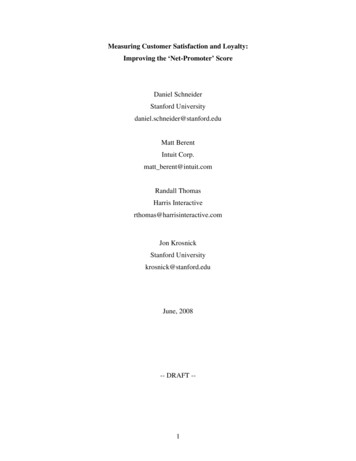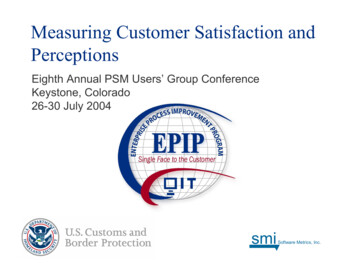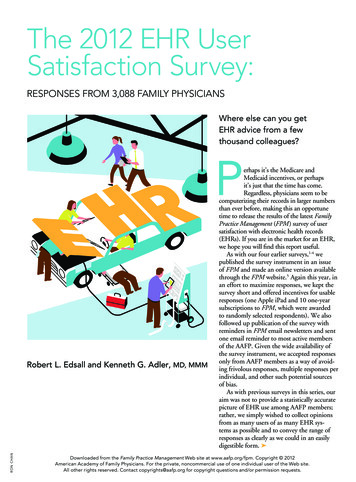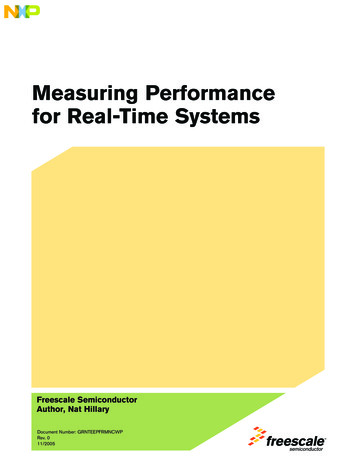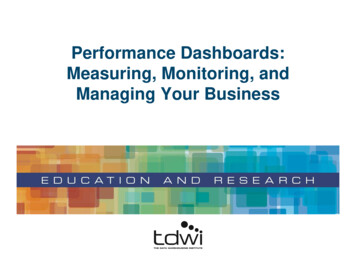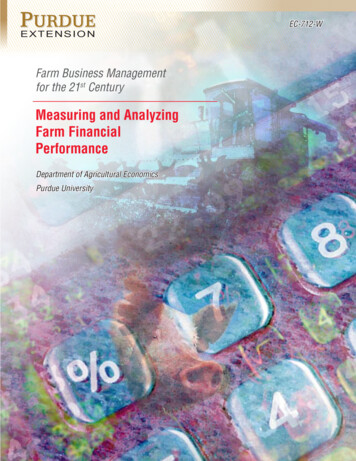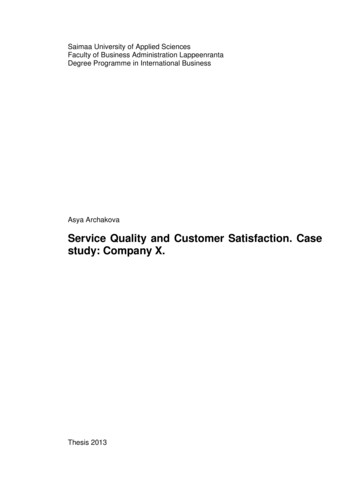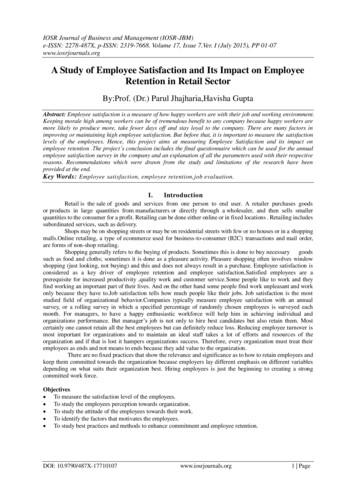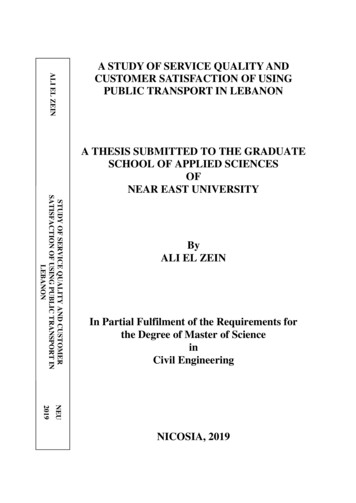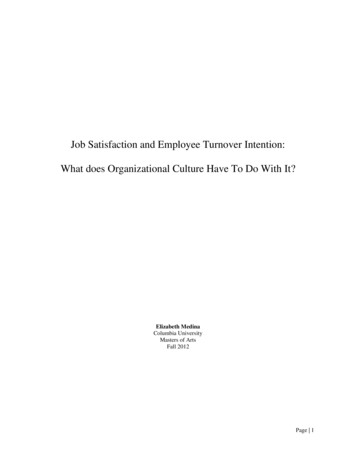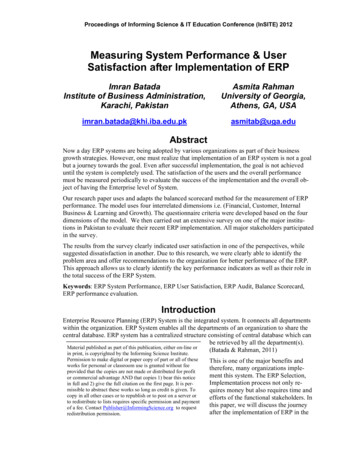
Transcription
Proceedings of Informing Science & IT Education Conference (InSITE) 2012Measuring System Performance & UserSatisfaction after Implementation of ERPImran BatadaInstitute of Business Administration,Karachi, PakistanAsmita RahmanUniversity of Georgia,Athens, GA, actNow a day ERP systems are being adopted by various organizations as part of their businessgrowth strategies. However, one must realize that implementation of an ERP system is not a goalbut a journey towards the goal. Even after successful implementation, the goal is not achieveduntil the system is completely used. The satisfaction of the users and the overall performancemust be measured periodically to evaluate the success of the implementation and the overall object of having the Enterprise level of System.Our research paper uses and adapts the balanced scorecard method for the measurement of ERPperformance. The model uses four interrelated dimensions i.e. (Financial, Customer, InternalBusiness & Learning and Growth). The questionnaire criteria were developed based on the fourdimensions of the model. We then carried out an extensive survey on one of the major institutions in Pakistan to evaluate their recent ERP implementation. All major stakeholders participatedin the survey.The results from the survey clearly indicated user satisfaction in one of the perspectives, whilesuggested dissatisfaction in another. Due to this research, we were clearly able to identify theproblem area and offer recommendations to the organization for better performance of the ERP.This approach allows us to clearly identify the key performance indicators as well as their role inthe total success of the ERP System.Keywords: ERP System Performance, ERP User Satisfaction, ERP Audit, Balance Scorecard,ERP performance evaluation.IntroductionEnterprise Resource Planning (ERP) System is the integrated system. It connects all departmentswithin the organization. ERP System enables all the departments of an organization to share thecentral database. ERP system has a centralized structure consisting of central database which canbe retrieved by all the department(s).Material published as part of this publication, either on-line or(Batada & Rahman, 2011)in print, is copyrighted by the Informing Science Institute.Permission to make digital or paper copy of part or all of theseworks for personal or classroom use is granted without feeprovided that the copies are not made or distributed for profitor commercial advantage AND that copies 1) bear this noticein full and 2) give the full citation on the first page. It is permissible to abstract these works so long as credit is given. Tocopy in all other cases or to republish or to post on a server orto redistribute to lists requires specific permission and paymentof a fee. Contact Publisher@InformingScience.org to requestredistribution permission.This is one of the major benefits andtherefore, many organizations implement this system. The ERP Selection,Implementation process not only requires money but also requires time andefforts of the functional stakeholders. Inthis paper, we will discuss the journeyafter the implementation of ERP in the
Measuring System Performance after Implementation of ERPOrganization. We will also discuss how to evaluate the overall ERP Performance from the userperspective.Related Works:Enterprise System helps organization to improve the overall communication and it helps the organization to achieve their strategic goals. ERP implementation is not only the implementation orinstallation of robust software; it is the achieved by the efforts of all the stakeholders of the organization.Successful implementation of ERP is not the selection of right product or selection of right vendors it is towards the utilization factor of the System. How much organization is dependent on theSystem is one of the key factors used to analyze the performance of the system.Relevant Methods for ERP Performance Measurement:There are several methods available for evaluating the performance of the ERP System. Most ofthe methods are based on metrics calculation evaluating the financial return of investment. However, in terms of the evaluation of an ERP system there are three Performance measurements thathave been identified by Chun Chin (Wei, Liou, & Lee-2008); they are construction of performance indicator, group ERP performance measurement, and analysis of result and system improvement. (Wei, Liou, & Lee. 2007)ERP Systems are enterprise level System so it is complex to measure the performance. The Analytical Approach based on the flow network model is used by (Chen, Lin. 2008) for measuring theperformance of ERP. Stochastic Flow network model is proposed to be used and then they proposed their algorithm for evaluating performance.In another research (Ho 2006) integrated approach was considered for evaluation the performanceof ERP. They observed the cost structure ratio and lead time uncertainty within the own operatingenvironment.The Balanced Scorecard Method highlights the four major perspectives of the organization (financial/cost, customer, internal processes, and innovation and learning) since it is covering all theareas and perspectives it is an efficient way of measurement. Project Perspectives were added inthe balanced scorecard approach by (Rosemann & Wiese 1999).Selection of Balanced Scorecard for ERP Performance System:The Balanced Scorecard method for ERP Performance System was successfully carried out in ahigher education institute in Karachi, Pakistan. The university had recently implemented the ERPSystem and they wanted to evaluate the overall performance of the System and assess the overalladvantage of the implementation of the System.Survey design:The university’s ICT Department prepared a questionnaire comprising 48 questions for evaluating the overall performance of the System. The questionnaire was distributed in the form of anonline survey system. All the major stake holders of the university participated in the survey andresults were recorded anonymously. The questionnaire was divided into four major categories i.e.Learning and Growth, Internal Business, Customer and Financial.Research method- Balanced scorecard:A balanced scorecard can be defined as a planning and management system that is commonlyused by organizations, companies etc. for monitoring or assessing the performance against the604
Batada & Rahmanglobal goals. The balanced scorecard has evolved from its early use as a simple performancemeasurement framework to a full strategic planning and management system.According to the balance scorecard approach we look at the organization from four perspectives.The four perspectives that were considered were Financial, Customer, Internal Business & Learning and Growth. Data was collected and analyzed relative to each of the perspective. Here is adiagram that illustrates the balanced scorecard method:Figure 1: Balance Scorecard approach for performance measurementSource: Kaplan & Norton, 1996Balanced Scorecard Implementation:Data for our research was collected in form of a survey. The survey consisting of 48 questionswas divided among the four perspectives. All the stake holders participated in the survey. Here isthe division of questions based on the perspectives:Learning and growth Perspective: 12Internal Business and Growth Perspective: 16Customer Perspective: 12Financial Perspective: 8605
Measuring System Performance after Implementation of ERPPerformance Evaluation:Perspective # 1: Learning and growthThis perspective was further divided into three matrices, enabling better classification of the questions. These three matrices consist of the following questions:Matrix 1:Question No 1: Is the ERP Data accurate? Learning and GrowthQuestion No 2: Are you comfortable to rely on the system information?Question No 3: Are you or your department capable to take care of your reporting requirements?Question No 4: Did the ERP System increase your productivity?Average Weightage of the questions: 5Average response score for this matrix: 3.88Score of Matrix 1: Weightage of questions * Score of questions 0.775Matrix 2:Question No 5: Are you getting up-to-date information from the System?Question No 6: Are you getting required information instantly from the System?Question No 7: The information which was only available via other departments earlier, is now available via the system.Question No 8: Strong Information Systems (IS) DepartmentAverage Weightage of the questions: 5Average response score for this matrix: 3.716Score of Matrix 2: Weightage of questions * Score of questions 0.7433Matrix 3:Question No 9: Technical knowhow of the ERP teamQuestion No 10: Strong and meaningful training programsQuestion No 11: Do you now have a decent understanding of ERP conceptsQuestion No 12: Did you already have a reliable IT infrastructure in placeAverage Weightage of the questions: 5Average response score for this matrix: 3.83Score of Matrix 3: Weightage of questions * Score of questions 0.7666The Performance of the perspective is now calculated by the following formula:Performance of Learning and Growth Perspective:Since there were three matrices in this perspective, they all have a weightage of .03333. Here isthe performance of our first perspective:Performance (Learning and growth Perspective) (0.333*0.775) (0.333*0.7433) (0.333*0.7666)Performance (Learning and growth Perspective) 0.761667606
Batada & RahmanPerspective # 2: Internal business perspective:This perspective was further divided into four matrices, enabling better classification of the questions. These four matrices consist of the following questions:Matrix 1:Question No 1: Is the System efficient to take your needs?Question No 2: Is the ERP System advantageous?Question No 3: Does the ERP system aid your decision making process?Question No 4: Are you getting good ERP Technical Support?Average Weightage of the questions: 5Average response score for this matrix: 3.98Score of Matrix 1: Weightage of questions * Score of questions 0.795Matrix 2:Question No 5: Are you or your department being trained on time?Question No 6: Does the ERP System ease your work load?Question No 7: Does the ERP system provide you accurate information for your daily routinetasks?Question No 8: Does the ERP System provide you the information for easy decision making?Average Weightage of the questions: 5Average response score for this matrix: 3.87Score of Matrix 2: Weightage of questions * Score of questions 0.7733Matrix 3:Question No 9: Did this implementation result in reduced paper workQuestion No 10: Did the feeling of ownership of the system improve after the implementationamong the functional users as well as end usersQuestion No 11: The interdepartmental relationships improvedQuestion No 12: Overall group / departmental productivity improvedAverage Weightage of the questions: 5Average response score for this matrix: 3.71Score of Matrix 3: Weightage of questions * Score of questions 0.741Matrix 4:Question No 13: Better coordination in between different departmentsQuestion No 14: Streamlined the business processesQuestion No 15: Increased overall satisfaction with business processesQuestion No 16: Improve the organizational processes as a wholeAverage Weightage of the questions: 5Average response score for this matrix: 3.733Score of Matrix 4: Weightage of questions * Score of questions 0.746607
Measuring System Performance after Implementation of ERPPerformance of Internal Business Perspective:Since there were four matrices in this perspective, they all have a weightage of .25. Here is theperformance of our second perspective:Performance (Internal Business Perspective) (0.25*0.795) (0.25*0.773) (0.25*0.741) (0.25*0.746)Performance (Internal Business Perspective) 0.76416Perspective # 3: Customer perspective:This perspective was further divided into three matrices, enabling better classification of the questions. These three matrices consist of the following questions:Matrix 1:Question No 1: Did you get any benefit out of resource utilization? CustomerQuestion No 2: Are you getting timely reports from the System?Question No 3: User’s involvement and participationQuestion No 4: For how long do you use the system daily?Average Weightage of the questions: 5Average response score for this matrix: 3.875Score of Matrix 1: Weightage of questions * Score of questions 0.775Matrix 2:Question No 5: Are you or your team capable to handle the ERP FunctionalSide?Question No 6: Is the ERP System user friendly?Question No 7: What is your opinion about the overall performance of the System?Question No 8: ERP simplifies user taskAverage Weightage of the questions: 5Average response score for this matrix: 3.558Score of Matrix 2: Weightage of questions * Score of questions 0.7116Matrix 3:Question No 9: Top management supportQuestion No 10: Functional areas supportQuestion No 11: ERP support within the organizationQuestion No 12: Your opinion about ERP software selectedAverage Weightage of the questions: 5Average response score for this matrix: 3.866Score of Matrix 3: Weightage of questions * Score of questions 0.7733608
Batada & RahmanPerformance of Customer Perspective:Since there were three matrices in this perspective, they all have a weightage of 0.33. Here is theperformance of our third perspective:Performance (Customer Perspective) (0.33*0.775) (0.33*0.7116) (0.33*0.773)Performance (Customer Perspective) 0.75333Perspective # 4: Financial perspective:This perspective was further divided into two matrices, enabling better classification of the questions. These two matrices consist of the following questions:Matrix 1:Question No 1 ERP helps in saving end user timeQuestion No 2: Was there a decrease in overall operating cost after implementing the System?Question No 3: Was there any staff reduction?Question No 4: Efficient change managementAverage Weightage of the questions: 5Average response score for this matrix: 3.691Score of Matrix 1: Weightage of questions * Score of questions 0.7383Matrix 2:Question No 5: Strategic planning for the ERP ProjectQuestion No 6: Forecasting process has been improvedQuestion No 7: Are you dependent on the ERP System for your daily operational activities?Question No 8: Has the system improved your performance?Average Weightage of the questions: 5Average response score for this matrix: 3.7333Score of Matrix 2: Weightage of questions * Score of questions 0.7466Performance of Financial Perspective:Since there were three matrices in this perspective, they all have a weightage of 0.5. Here is theperformance of our fourth perspective:Performance (Financial Perspective) (0.50*0.7383) (0.50*0.7466)Performance (Financial Perspective) 0.7425609
Measuring System Performance after Implementation of ERPCalculation of overall performance:Overall Performance: (0.761667 0.76416 0.75333 0.7425)/4Overall Performance: 0.755416667Evaluation Criteria:The following scale was used to measure the performance of our system:Scale:Excellent0.81 to 0.10Good0.61 to 0.8Fair0.51 to 0.6Poor0.0 to 0.5Critical AnalysisOur overall performance score as calculated above is 0.755416667, which falls under the rankingof “Good” in the standard scale. We can see the performance of each perspective to evaluate theareas that need more improvement. Our performance was equal in all the perspectives, however,as we can see the financial perspective scored the least. Based on this evaluation, we can conclude that this perspective needs improvement. We can improve is by decreasing the over-all costof the implementation as well as by providing more value to its users in terms of decreasing thedaily operational costs.Learning & Development showed 0.76 which indicates that there is a good room for improvement. It has the areas of accuracy of data, productivity of users, reliance on the system of the userand reporting requirements. 0.76 falls in the “good” category but it still a little far from excellent.Internal Business Perspective showed 0.79; which also indicates the room for improvement in thisarea. It includes the areas of training; ease your work load, daily routine operations and the decision making. This can be improved by arranging more training sessions so that users will gettrained or they get a refresher of the system. This will definitely improve the reliance of the system ratio and finally they would be able to take decision via the System.Customers Perspective showed 0.75 is also good rating but can be improved by providing functional area support, inter departmental meetings, rewards from the top management etc. ERP System is interconnected with other departments therefore; the interdepartmental support is requiredto increase the ranking of this phase.Financial Perspective showed 0.74 indicating it has room for improvement as well. Improvementin this phase will definitely help organization in terms of overall growth.ConclusionMeasurement of ERP System’s performance is necessary for the organization both who recentlyimplemented as well as for those who implemented it in last several years. It is necessary for allthe stakeholders to participate in the evaluation process. This will enable the organization to make610
Batada & Rahmanproper improvements. Balanced Scorecard helps the organization evaluate the system based onfour major perspectives.In this research we used Balance Scorecard for evaluating the performance of ERP System. Questionnaire was prepared and extensive online survey was conducted to evaluate four major perspectives. Over-all our evaluation rated the implementation as “good’. It also provided in depthanalysis on various areas of improvements. With the help of the balance scorecard approach, thesystem was evaluated on four major criterions.ReferencesBatada, I., & Rahman, A., (2011). Selection, implementation & post production of an ERP System. Proceedings of the 2nd International Conference on Information Management and Evaluation.Chen, S., & Lin, Y. (2008). An evaluation method for enterprise resource planning systems. Journal of theOperations Research Society of Japan.Dahne, S., Hohne, J., & Tangermann M. (2011). Adaptive classification improves control performance inERP-based BCIs. Proceedings of the 5th International BCI Conference 2011.Ho, C. (2006). Measuring system performance of an ERP-based supply chain. International Journal ofProduction Research.Hyvonen, J. (2007) Strategy, performance measurement techniques and information technology of the firmand their links to organizational performance. Management Accounting Research, 18.Kaplan, R. S., & Norton, D. P. (1996). Using the balanced scorecard as a strategic management system,Harvard Business Review.Rosemann, M., & Wiese, J. (1999). Measuring the performance of ERP software– A balanced scorecardapproach. 10th Australasian Conference on Information Systems, 1999. .Wei, C., Liou, T., & Lee, K. (2008). An ERP performance measurement framework using a fuzzy integralapproach. Journal of Manufacturing Technology Management.BiographiesImran Batada is a senior IT Professional with over 10 years of experience in the IT industry. As an IT Professional he has worked inUSA and Asia.He is currently working in Institute of Business Administration, Karachi Pakistan as Head of Information System Department. He is alsoresponsible for overall ERP Implementation.Asmita Rahman, raised in Los Angeles California, currently pursuingher Masters in Computer Science from the University of Georgia. Shecompleted her Bachelors in Computer Science from California StateUniversity in 2009. Her Areas of research include ERP implementation, post implementation of ERP and Semantic Web.611
Enterprise Resource Planning (ERP) System is the integrated system. It connects all departments within the organization. ERP System enables all the departments of an organization to share the central database. ERP system has a centralized structure consisting of central database which can be ret
